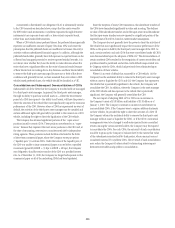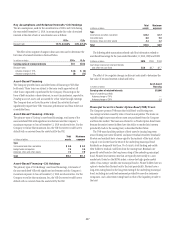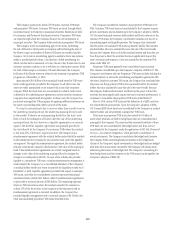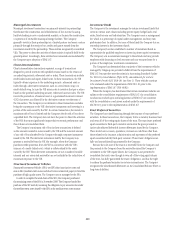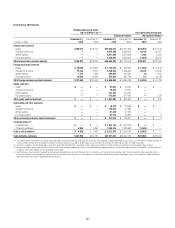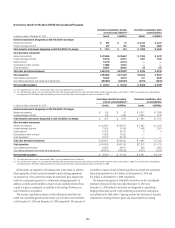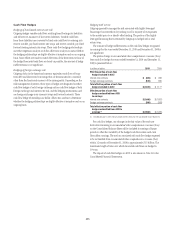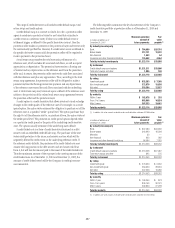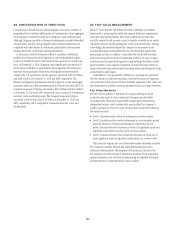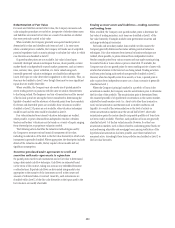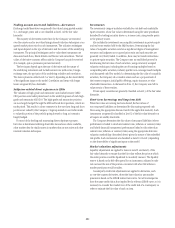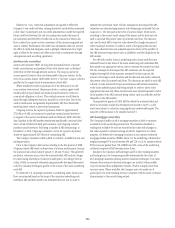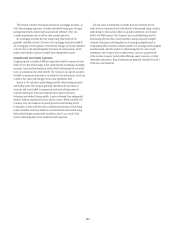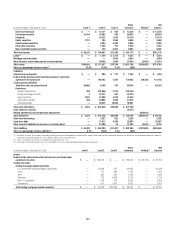Citibank 2010 Annual Report Download - page 258
Download and view the complete annual report
Please find page 258 of the 2010 Citibank annual report below. You can navigate through the pages in the report by either clicking on the pages listed below, or by using the keyword search tool below to find specific information within the annual report.256
Net Investment Hedges
Consistent with ASC 830-20, Foreign Currency Matters—Foreign
Currency Transactions (formerly SFAS 52, Foreign Currency
Translation), ASC 815 allows hedging of the foreign currency risk of a
net investment in a foreign operation. Citigroup uses foreign currency
forwards, options, swaps and foreign currency denominated debt instruments
to manage the foreign exchange risk associated with Citigroup’s equity
investments in several non-U.S. dollar functional currency foreign
subsidiaries. Citigroup records the change in the carrying amount of these
investments in the Foreign currency translation adjustment account
within Accumulated other comprehensive income (loss). Simultaneously,
the effective portion of the hedge of this exposure is also recorded in the
Foreign currency translation adjustment account and the ineffective
portion, if any, is immediately recorded in earnings.
For derivatives used in net investment hedges, Citigroup follows the
forward-rate method from FASB Derivative Implementation Group Issue H8
(now ASC 815-35-35-16 through 35-26), “Foreign Currency Hedges:
Measuring the Amount of Ineffectiveness in a Net Investment Hedge.”
According to that method, all changes in fair value, including changes
related to the forward-rate component of the foreign currency forward
contracts and the time value of foreign currency options, are recorded in the
foreign currency translation adjustment account within Accumulated other
comprehensive income (loss).
Foreign currency translation adjustment account. For foreign
currency denominated debt instruments that are designated as hedges of
net investments, the translation gain or loss that is recorded in the foreign
currency translation adjustment account is based on the spot exchange
rate between the functional currency of the respective subsidiary and the
U.S. dollar, which is the functional currency of Citigroup. To the extent the
notional amount of the hedging instrument exactly matches the hedged
net investment and the underlying exchange rate of the derivative hedging
instrument relates to the exchange rate between the functional currency of
the net investment and Citigroup’s functional currency (or, in the case of
a non-derivative debt instrument, such instrument is denominated in the
functional currency of the net investment), no ineffectiveness is recorded
in earnings.
The pretax loss recorded in the Foreign currency translation
adjustment account within Accumulated other comprehensive income
(loss), related to the effective portion of the net investment hedges, is
$3.6 billion and $4.7 billion for the years ended December 31, 2010 and
December 31, 2009, respectively.
Credit Derivatives
A credit derivative is a bilateral contract between a buyer and a seller
under which the seller agrees to provide protection to the buyer against the
credit risk of a particular entity (“reference entity” or “reference credit”).
Credit derivatives generally require that the seller of credit protection make
payments to the buyer upon the occurrence of predefined credit events
(commonly referred to as “settlement triggers”). These settlement triggers
are defined by the form of the derivative and the reference credit and are
generally limited to the market standard of failure to pay on indebtedness
and bankruptcy of the reference credit and, in a more limited range of
transactions, debt restructuring. Credit derivative transactions referring to
emerging market reference credits will also typically include additional
settlement triggers to cover the acceleration of indebtedness and the risk of
repudiation or a payment moratorium. In certain transactions, protection
may be provided on a portfolio of referenced credits or asset-backed securities.
The seller of such protection may not be required to make payment until a
specified amount of losses has occurred with respect to the portfolio and/or
may only be required to pay for losses up to a specified amount.
The Company makes markets in and trades a range of credit derivatives,
both on behalf of clients as well as for its own account. Through these
contracts, the Company either purchases or writes protection on either a
single name or a portfolio of reference credits. The Company uses credit
derivatives to help mitigate credit risk in its Corporate and Consumer loan
portfolios and other cash positions, to take proprietary trading positions, and
to facilitate client transactions.


